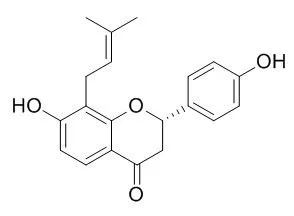| In vitro: |
| Acta Pharmacol Sin. 2011 Apr;32(4):425-32. | | Promoting effects of isobavachin on neurogenesis of mouse embryonic stem cells were associated with protein prenylation.[Pubmed: 21441946] | Some small molecules can induce mouse embryonic stem (ES) cells to differentiate into neuronal cells. Here, we explored the effect of Isobavachin (IBA), a compound with a prenyl group at position 8 of ring A, on promoting neuronal differentiation and the potential role of its protein prenylation.
METHODS AND RESULTS:
The hanging drop method was employed for embryonic body (EB) formation to mimic embryo development in vivo. The EBs were treated with Isobavachin at a final concentration of 10(-7) mol/L from EB stage (d 4) to d 8+10. Geranylgeranyltransferase I inhibitor GGTI-298 was subsequently used to disrupt protein prenylation. Neuronal subtypes, including neurons and astrocytes, were observed by fluorescence microscopy. Gene and protein expression levels were detected using RT-PCR and Western blot analysis, respectively. With Isobavachin treatment, nestin was highly expressed in the neural progenitors generated from EBs (d 4, d 8+0). EBs then further differentiated into neurons (marked by β-tubulin III) and astrocytes (marked by GFAP), which were both up-regulated in a time-dependent manner on d 8+5 and d 8+10. Co-treatment with GGTI-298 selectively abolished the Isobavachin-induced neuronal differentiation. Moreover, in the MAPK pathway, p38 and JNK phosphorylation were down-regulated, while ERK phosphorylation was up-regulated after Isobavachin treatment at different neuronal differentiation passages.
CONCLUSIONS:
Isobavachin can facilitate mouse ES cells differentiating into neuronal cells. The mechanism involved protein prenylation and, subsequently, phos-ERK activation and the phos-p38 off pathway. | | Food Chem Toxicol. 2007 Jan;45(1):119-24. | | Prenylation enhances cytotoxicity of apigenin and liquiritigenin in rat H4IIE hepatoma and C6 glioma cells.[Pubmed: 17045382 ] | Antioxidative as well as cytotoxic effects of the prenylated flavonoids licoflavone C (8-prenylapigenin) and Isobavachin (8-prenylliquiritigenin) were investigated in comparison to the corresponding non-prenylated flavonoids (apigenin, liquiritigenin) and vitexin (apigenin-C8-glucoside) using metabolically active H4IIE hepatoma and metabolically poorly active C6 glioma cells.
METHODS AND RESULTS:
None of the substances showed radical scavenging activities in the 2,2-diphenyl-1-picrylhydrazyl (DPPH)-assay nor were they effective in protection against H2O2-induced intracellular 2',7'-dichlorodihydrofluorescein (H2DCF) oxidation (fluorescent probe for oxidative stress) in H4IIE and C6 cells. When the intrinsic effects of the substances were investigated, licoflavone C and Isobavachin exerted a pronounced toxicity in both H4IIE (IC50 values of 42+/-5 and 96+/-19 micromol/L) and C6 cells (IC50 values of 37+/-6 and 69+/-3 micromol/L) while the non-prenylated analogues as well as the glycosylated derivate vitexin showed almost no cytotoxic effect up to 250 micromol/L. In H4IIE cells the induction of apoptotic cell death by licoflavone C and icobavachin was detected as an activation of caspase 3/7 (6- and 3.3-fold, respectively).
CONCLUSIONS:
Based on these experiments we suggest that C8-prenylation of a flavonoid enhances the cytotoxicity inducing an apoptotic cell death in H4IIE cells without affecting antioxidative properties. |
|






 Cell. 2018 Jan 11;172(1-2):249-261.e12. doi: 10.1016/j.cell.2017.12.019.IF=36.216(2019)
Cell. 2018 Jan 11;172(1-2):249-261.e12. doi: 10.1016/j.cell.2017.12.019.IF=36.216(2019) Cell Metab. 2020 Mar 3;31(3):534-548.e5. doi: 10.1016/j.cmet.2020.01.002.IF=22.415(2019)
Cell Metab. 2020 Mar 3;31(3):534-548.e5. doi: 10.1016/j.cmet.2020.01.002.IF=22.415(2019) Mol Cell. 2017 Nov 16;68(4):673-685.e6. doi: 10.1016/j.molcel.2017.10.022.IF=14.548(2019)
Mol Cell. 2017 Nov 16;68(4):673-685.e6. doi: 10.1016/j.molcel.2017.10.022.IF=14.548(2019)